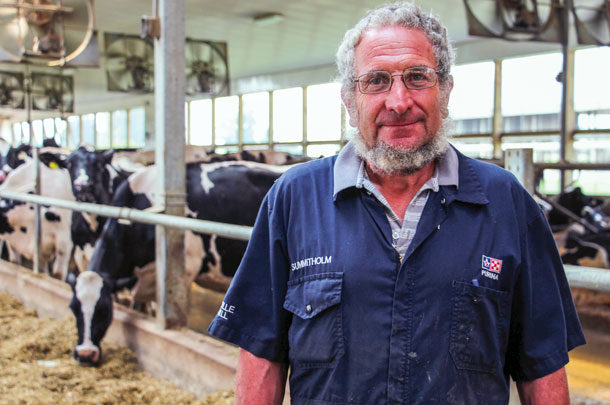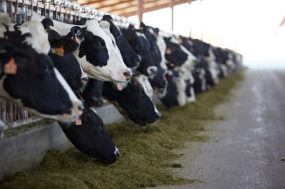The secret is comfort. That’s what Dave Loewith, part-owner of Joe Loewith & Sons Ltd., in Lynden, Ontario, says is the reason they held Holstein International’s title of breeding more 100,000-kilogram cows than anyone else in the world.
When the Loewiths build a new barn, they make their decisions based on what is best for the cows. In addition, they adhere to keeping the stocking density low and providing education and training on cow comfort to their employees.
What have you done in the past year to improve cow comfort on your farm?
“Over the past while, we have done two things to improve cow comfort.
“After being in our original sand-bedded barn for many years, we noticed the back ends of the stalls were getting quite compacted. Even though the stalls looked fine, we decided to excavate the back about 3 feet of each stall."
"This was relatively easy, as we used a small backhoe and pushed out the debris with our skid steer. We then refilled the stalls with fresh sand. In some groups, we noticed a significant increase in lying time, up to one hour more."
“Then, this past summer during the hot days, the cows were bucking in the centre of the barn even though the fans were running and one group had sprinklers. The barn is orientated north-south with curtain-sided walls and five doors across the ends."
"On the advice of our nutritionist, we closed all the end doors. Whether the cows do not like the sunshine, or whatever it may be, they immediately became much better dispersed throughout the barn.”
PHOTO: Photo courtesy of Joe Loewith & Sons Ltd.
—Dave Loewith, dairy producer, Joe Loewith & Sons Ltd.
Read the story here: Raising 100,000-kilogram cows: Dairyman shares his secrets to success
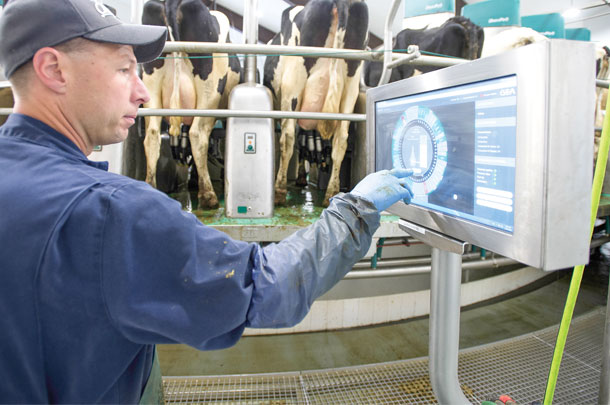
2. Automatic rotary parlour milks more cows in less time at Gracemar Farms
Published October 2016
In March 2016, Gracemar Farms became the first farm in North America to milk cows in an automated 60-stall rotary parlour.
“This way, we can move to a faster parlour and still have the efficiency of one man managing it,” John Kampman says. He farms with his two brothers-in-law, Richard and Michael Tenbrinke, on the Chilliwack, British Columbia, farm started by their father, Wally Tenbrinke, and his brothers in the 1970s.
Kampman continues to fill a shift in the parlour each day. For the most part, his role in the automated parlour is to monitor its performance. There’s a touch screen with a picture of the rotary that alerts him to cows that may require attention.
If a machine slips off, he can look at the cow on the screen and her data to see if she needs reattachment or not.
Previously, it took the farm six hours to milk 650 cows. Now, it can milk 1,050 cows in four-and-a-half hours with spraydown. That person is now free to do other tasks, such as cleaning up the parlour, pressure washing or tractor work because their shift isn’t full with just milking.
By automating the milking system, the owners of Gracemar Farms have been able to grow the farm without removing them from their active daily responsibilities.
PHOTO: John Kampman monitors the 60-stall automatic rotary parlour from a touch screeen in the parlour. Courtesy photo.
Read the story here: Automatic rotary parlour milks more cows in less time at Gracemar Farms
3. What are the freestall farms with low lameness doing differently?
Published October 2017
As part of a Canada-wide cow comfort study, the University of Calgary’s Lameness Research Team visited more than 140 freestall farms and evaluated more than 5,600 cows to investigate which risk factors were associated with lameness.
The team spent five to eight hours on each farm collecting data on dozens of factors that can affect lameness, related to individual cows, management practices and facility design.
Average lameness prevalence was 21 percent but, as expected, there was large variation among farms. In some farms, fewer than 5 percent of cows were lame but, in others, up to 65 percent were lame.
In general, the farms with low lameness prevalence provided more comfortable lying and walking surfaces by using sand or dried manure as the stall base, by having deep-bedded stalls and by maintaining non-slippery floors.
In the follow-up study, 87 percent of producers changed bedding quantity, frequency or type. What was the change in frequency?
“Producers who changed bedding frequency did so to more than once a week. That is, they increased bedding frequency from once or less than once a week to twice or more than twice a week.
“However, we can’t know for sure if just changing bedding frequency alone had an impact on lameness, body injuries and lying time. Most of the producers that changed bedding frequency did so because they also increased bedding quantity (from little to deep bedding)."
"Both changes – bedding frequency and quantity – would likely have a positive impact on the cleanliness, dryness and comfort of the stall surface.”
—Laura Solano, dairy cattle extension specialist, Farm Animal Care Associates
Read the story here: What are the freestall farms with low lameness doing differently?
4. Feeding grain according to individual production – for better or worse?
Published October 2016
Years after the adoption of TMR feeding to better balance the intake of grains and forages, the use of automated milking systems has prompted the return of computerized concentrate feeding separate from the forages at the bunk.
Alan Vaage wrote, “The biggest issue with the feeding of concentrates to cows individually is the challenge to achieve peak milk production without experiencing a significant incidence of digestive upset and feet and leg problems over time.”
Providing a small amount of concentrate, perhaps up to 1 kilogram per milking, is useful and sometimes necessary to entice cows into a robotic milking machine to be milked. However, Vaage said higher levels have created similar problems to those experienced with computerized grain feeders in the past.
Do you feel cow traffic to automated milking systems can be maintained without grain fed separately at the robot?
“Behaviourly, I believe lactating dairy cows experience a degree of comfort and satisfaction at having mammary gland distension reduced by milking – and thus inherently have a desire to be milked."
"If this is the case, providing grain may not be required to maintain adequate milking rates with automated milking systems, as it proved to not be required to entice cows to enter other milking parlors, including rotary parlors."
"Unfortunately, I am not yet aware of anyone who has had the nerve to remove grain feeding from an automated milking system for a sufficient length of time to determine its ultimate effect on animal behaviour and milk production."
"We might be surprised. For example, there might be less interference at the robot from dominant animals trying to monopolize the source of supplemental feed.”
—Alan S. Vaage, ruminant nutritionist, Jaylor Fabricating Inc.
Read the story: Feeding grain according to individual production – for better or worse?
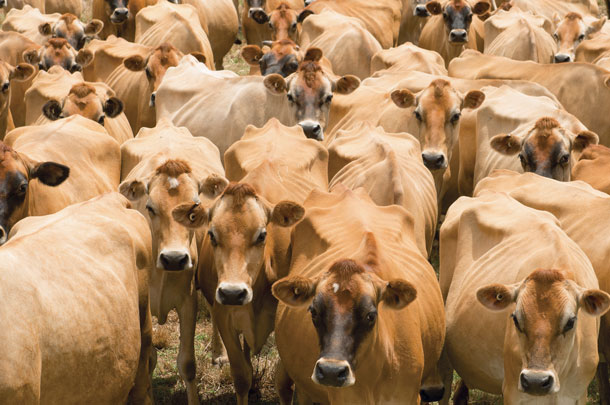
5. What will the ideal cow look like in 2025?
Published June 2017
Because the planet is on a fast-track route to go hungry, there will be more expectations and more eyes on the dairy industry as a true factory to produce milk and solids; the cow, however, must now meet a simple basic need for the consumer of tomorrow: healthy milk produced in quantity and in an efficient way.
Dairy cows in the Western world need to be evaluated on criteria that meet the expectations and necessities of the 8.1 billion consumers in 2025. Jean-François Thouny listed the four criteria for the dairy cow to be successful in 2025 as:
- Greater food efficiency to transform less food and water through the rumen for each kilogram of nutrient produced
- More milk production and solids per cow utilizing genetic resources and environment to achieve daily peaks of 90 kilograms and more in the near future
- Increasing milk components, specifically casein and fatty acids, to build the future of the industry to suit populations made of diverse histories and cultures
- A problem-free cow with robust health genes
Of the four criteria you outlined for the cow of the future, which one is most important for dairy producers to start improving today?
“Our ideal cow of 2025 will need to produce more efficiently. Each acre of arable land enters in a competition for feeding either humans or animals, or being used for other purposes.
"Therefore, in my opinion, the criteria with the most needed attention today is food efficiency – kilograms of milk by quantity of solid and liquid ingested.
“Feed efficiency is in the same range of heritability as milk production. It can be improved by genetics. Right now, zero emphasis is put on it. No improvement has been made because it is not at all correlated to any other trait.
“For a 200-cow dairy, more than 2,000 tons of dry matter are served yearly to the milking herd. All farmers are concerned about how much this costs and how much milk sales these 2,000 tons will bring to the bottom line. New opportunities will arise to address this issue.”
PHOTO: Courtesy photo.
—Jean-François Thouny, Ontario manager, STGenetics of Canada
Read the story here: What will the ideal cow look like in 2025?
6. Heat stress: Feeding strategies to maintain productive dairy cows
Published July 2017
One of the behavioural responses to heat stress is reduced feed intake, resulting in a decrease in milk production that can lead to acidosis.
Heat stress can require extended care of sick cows and lead to difficult births, heat exhaustion, mastitis and adverse reactions to vaccinations, which can result in abortions and death.
There are mechanical ways to combat heat stress with fans and sprinklers, but in this article, Silvio Miranda and Christina Straathof offer five nutritional strategies to tackle heat stress.
They look at how different approaches to water, energy, protein, fibre and minerals can help minimize heat stress.
What is the ideal time to implement these feeding strategies to combat heat stress?
“The five feeding strategies mentioned in the article should be implemented at least one week before the first heat wave occurs, which is defined as three days of temperatures of 32ºC or above (89.6ºF).”
—Silvio Miranda, Canadian dairy technical manager, Alltech
Read the story here: Heat stress: Feeding strategies to maintain productive dairy cows
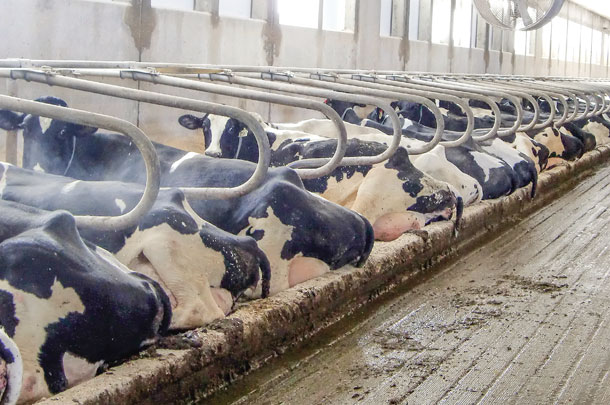
7. What we’ve learned about lying behaviour in freestall barns
Published March 2017
With an increase in automated measures of cow behaviour, lying time has become an indicator of disease and cow comfort. Many researchers and the Canadian Dairy Code of Practice have recommended a target of 12 hours per day of lying time.
However, Laura Solano wrote, “Lying is a complex behaviour affected by many factors, and an average number for a herd doesn’t tell the whole story.”
In a study by the Calgary Lameness Research Team, on most farms (92 percent), cows did not reach the recommended target of 12 hours per day of rest.
On average, cows were lying down for 10 hours 36 minutes per day. Lying behaviour was different between lame and non-lame cows. However, lame cows exhibited both extremely long and extremely short lying times.
Cows change their lying behaviour depending on days in milk, lactation number, health status and other demands on their time budgets.
Recommendations about optimum lying times must take these factors specific to the cow into account instead of focusing on an average number for the herd at any point in time.
If you could create a device, what parameters would it measure to detect lameness?
“There are several devices/systems with potential for early lameness detection. Some systems measure changes in locomotion (i.e., hoof placement, weight, pressure, step overlap, back arch), activity (i.e., number and speed of steps, neck activity, feeding, ruminating) or standing and lying behaviour."
"The most accurate device or system will likely have to combine information from different activity and behaviour data on a day-to-day basis to detect different patterns.
“Based on data from previous studies, parameters that seem to be promising if combined are: neck activity, lying behaviour, ruminating, milk yield, lactation stage and number."
"In addition, I believe these devices need to be adjustable and customized to the farm, taking into account parameters such as the type of stall base, bedding, stocking density and the farm’s degree of lameness.”
PHOTO: To achieve greater lying times, rest should be prioritized and encouraged by maintaining a comfortable lying surface. Photo provided by Laura Solano.
—Laura Solano, dairy cattle extension specialist, Farm Animal Care Associates
Read the story here: What we’ve learned about lying behaviour in freestall barns
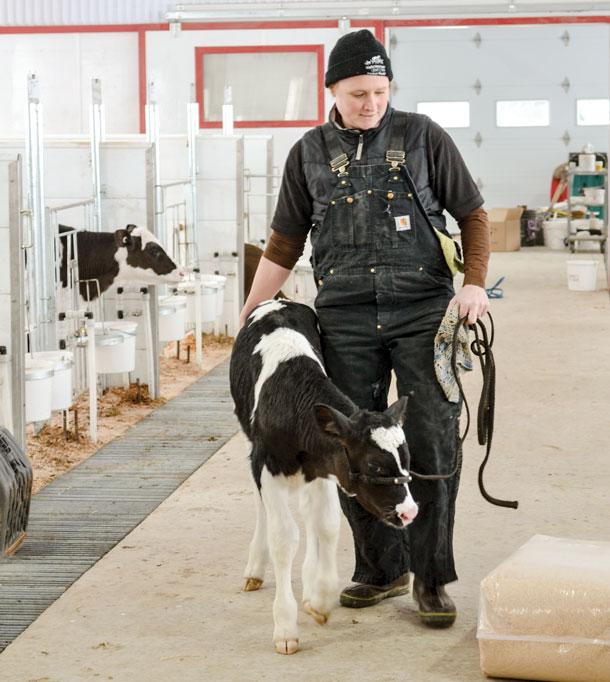
8. Anderson Farms raises heifers as if they were their children
Published August 2017
Anderson Farms in Howick, Quebec, milks 100 cows and farms 1,100 acres, which includes 4,600 maple trees. The farm’s owners give a lot of attention to replacement heifers since they are their future milking cows.
Due to the constant efforts of the team, composed of Mark Anderson and his wife, Jodi Wallace; his brother, Danny, and his wife, Dawn; his father, Robert, and his wife, Penny; the farm now weans its calves at 56 days old, weighing more than twice their birthweight.
They stress the importance of considering calves as if they were children. For example, if the bedding is dirty to the point you would not let a child sleep in it, do not let a calf lie down without taking a corrective action.
In the same way, if the calf’s milk bottle is not clean enough for a baby to drink from, do not let a calf drink from it either.
Can you please describe the labour force you have dedicated to calf care on your farm?
“Everyone on the farm is focused on ensuring newborn calves get clean, high-quality colostrum as soon as possible. Most often, calves are fed within the first hour. Calves get three feedings of fresh colostrum.
“Calves are then fed free-choice acidified milk. As such, milk is mixed every two days, and the system is washed once a week. Calf chores take about an hour in the morning and 15 minutes in the afternoon."
"The morning chores consist of cleaning pens (all pens are scraped clean twice a week), fresh grain, water and hay is given to each pen. The barn floors are also swept."
"The afternoon chores are done by our four kids, ages 5 to 10. They feed grain, water and hay to all calves. Weaned pens are scraped, and bedding is added as needed.”
PHOTO: Jodi Wallace walks in the nursery with one of her “little ones.” The nursery has a heated floor (except in the pens), as well as positive-pressure ventilation tubes. Photo provided by Jodi Wallace.
—Dr. Jodi Wallace, dairy producer, Anderson Farms
Read the story here: Anderson Farms raises heifers as if they were their children
9. Gert Schrijver gets peak production with forage quality, transition cow management
Published online December 2016
Gert Schrijver and his wife, Sonja, started Mars Dairy near Stettler, Alberta, in 1996 after emigrating from the Netherlands. Today, they have 230 cows (370 kilograms of quota), 260 heifers and 850 acres.
They also recently achieved the highest milk production in Alberta at more than 14,000 litres of milk per cow in 305 days. The herd is milked three times a day, and its somatic cell count varies between 100,000 and 150,000. The farm has a 23 percent cull rate.
Schrijver attributed seven different factors to the farm’s success in production. The two main factors are transition management and forage quality, and the other factors include feedbunk management, sand bedding for cow comfort and udder health, heifer raising, labour and conformation.
How close are you to reaching your goal of producing 60,000 litres in four lactations with 3.8 fat and a 14-month calving interval?
“We reached our goal. For the last four months, we achieved production levels between 1.9 and 2 kilograms of fat per cow per day with dry matter intakes of 27 to 27.5 kilograms per cow per day.
By improving cow comfort (sand bedding), increasing forage quality and developing protocols for mixing feed, we increased our butterfat to 4.3 percent with 46 kilograms of milk.
“We like to focus on kilograms of fat and protein per day of life. Currently, these numbers are not available by breed improvement. We feel measuring our herd based on kilograms of fat and protein per day of life gives the most accurate information about the economics of longevity and leads to higher return over feed cost per cow and lower feed cost per kilogram of milk.
Measuring longevity based on numbers of lactation is not very useful; you have to include milk production.”
—Gert Schrijver, dairy producer, Mars Dairy
Read the story here: Gert Schrijver gets peak production with forage quality, transition cow management
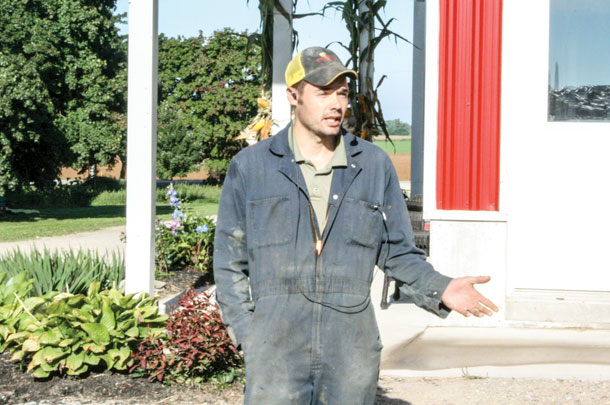
10. Haags use new barn to bring all of their cows back home
Published online January 2017
In taking over the farm his parents started when they moved from Switzerland in 1990, Roger Haag and his wife, Karen, consolidated two separate farms and looked to automation to reduce labour needs.
After seven years of milking cows on two separate farms and keeping dry cows at a third location, the Haag family decided it was time to consolidate.
In 2015, they constructed a new sand-bedded freestall barn with natural ventilation and three automated milking systems to milk the farm’s combined 130 to 140 cows. Now almost every animal is back at the home farm, with the exception of 80 to 90 heifers kept at the other farm.
“We’re really happy with the robots,” Roger Haag said. The herd was milked twice a day, and now it is averaging well over three times a day. “That helps tremendously, especially with fresh cows up to five times. They peak extremely well,” he added.
How has your farm management improved with your new facility compared to your previous style with two locations?
“Farm management has definitely improved because all milking and dry cows are in one barn; this allows for much easier movement of cows from milking to dry and from dry to calving to milking.
This saves us time and is much less stressful for cows when they don’t have to be moved with a cattle trailer.
“Also, it is easier having the cows in one computer system as opposed to two. This new facility is more cow- and labour-friendly, which gives us more time to focus on the cows and improves management by providing more daily data such as milk weights, somatic cell count, activity and rumination.
The cows perform better, are healthier and show much stronger heats, which all makes management easier for us.”
PHOTO: Roger Haag welcomes the Progressive Dairy Operators bus tour to his farm, Breezy Holsteins, on Sept. 16, 2016. Photo by Karen Lee.
—Roger and Karen Haag, dairy producers, Breezy Holsteins
Read the story here: Haags use new barn to bring all of their cows back home
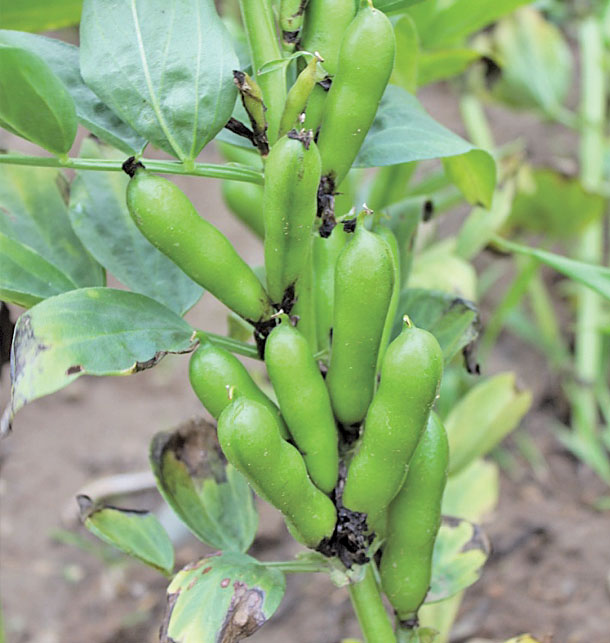
11. Get the facts on faba beans
Published October 2016
With many feed ingredients available to producers, protein is still a sought-after nutrient, not necessarily due to lack of availability but the fluctuating yet increasing costs associated with protein.
Although not a new crop for western Canada, for Ontario, the faba bean is somewhat novel, and interest is rising.
The common reason for livestock producers to plant faba beans is to obtain a protein source that is homegrown and can easily be processed on-farm, as they contain little oil.
They also do not contain anti-nutritional enzymes and, therefore, do not need roasting. Faba beans, related to lima beans, contain approximately 30 percent protein and provide a good source of energy from starch.
In this article, Anita Heeg breaks down everything you need to know about faba beans, from their nutritional profile to growing and harvesting.
Did the number of acres planted to faba beans continue to rise in 2017?
“Southern Ontario saw a slight increase of a few hundred acres of faba beans for an approximate total of 1,400 acres. The majority of the faba beans were grown for on-farm feed.
In northern Ontario, the acreage of faba beans significantly dropped due to a resurgence of canola and yellow peas. However, some acreage is still grown in northern Ontario for own use.”
—Anita Heeg, feed ingredients and byproducts specialist, OMAFRA
Read the story here: Get the facts on faba beans
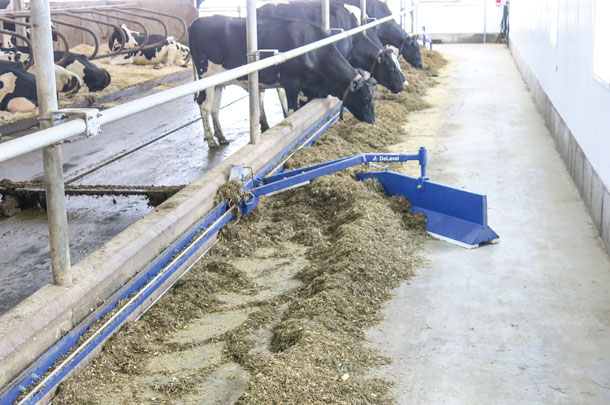
12. Five key benefits of frequent feed push-up
Published January 2017
Outstanding performance on a dairy farm starts with the basics. Those basics include keeping food in front of your cows at all times to help ensure top milk quality from the very beginning.
Cows cannot eat what they cannot reach or do not have. Jim Mattox, solution manager – feeding systems and nutrition, DeLaval North America, suggested dairy producers should seriously consider implementing effective feed manipulation on their dairy for the following reasons:
-
Higher DMI – The more your cows eat, the more milk they are able to produce. Additionally, ration consistency is critical. Studies show that as ration consistency varies, dry matter intake suffers, which may result in lower milk production.
-
Improved butterfat – More meals per day can result in approximately a 4 percent increase in fat-corrected milk.
-
Less refusals – One of the things Mattox observed when working with herds that frequently push feed is a significantly lower refusal rate.
-
Longer standing after milking – Eating after milking increases standing time. A cow that stands longer allows more time for the teat canal to close, reducing the risk for mastitis.
- Better robotic traffic – If all cows get up and rush the feedbunk at once, they may then start queuing up in front of the robot. Frequent feed manipulation allows the herd to get in a very consistent rhythm with a more consistent throughput.
By keeping quality feed in front of cows at all times, you can help manage your herd so cows have a healthy and productive life.
PHOTO: Increasing the frequency of feed manipulation is becoming a hot topic in the dairy industry. Photo provided by Jim Mattox.
Read the story here: Five key benefits of frequent feed push-up
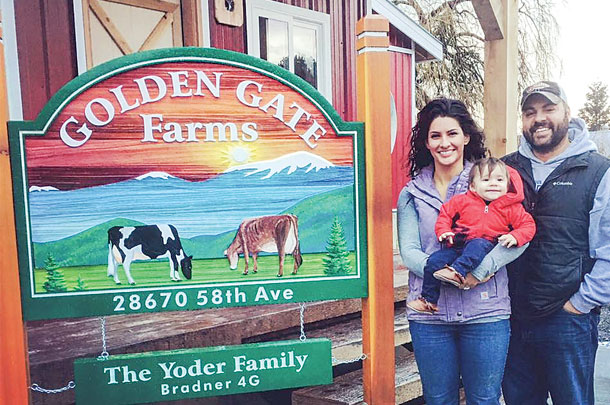
13. Golden Gate Farms maintains organic production, cuts inputs with automation
Published January 2017
Martin and Sarah Yoder set up their dairy business, Golden Gate Farms, on 40 acres across the road from Sarah’s parents near Abbotsford, British Columbia.
Her father, Rob, made the change to organic farming and was the first to produce and ship organic milk in western Canada, a practice Sarah and Martin have continued.
With a small land base, it is necessary for the Yoders to purchase all of their feed, but this is not much of a problem as both Sarah’s dad and brother farm in the area.
They both produce organic milk and crops, and they are the Yoders’ source for organic feed. Sarah’s dad utilizes manure from the operation.
The couple enjoyed their first year in a new barn, which they moved into in February 2016. This barn has three rows of freestalls with one feed alley along the outside. It has an automated feed system and two automated milking systems.
The Yoders say the robots are a help with organic production due to the health alerts that warn them if something is going amiss. They feel their cows are stress-free and therefore happier and healthier.
Can you please describe the current demand you are seeing for organic dairy products?
“Since we transitioned to certified organic production in 1998, we have seen huge amounts of growth in demand for organic milk products in British Columbia.
“In 2006, there were 14 organic producers in British Columbia shipping 93,000 hectolitres a year. This was not enough to keep up with the growing demand. Today, there are now 27 organic producers in the province producing 287,000 hectolitres a year.
“In 2006, there were 147 organic producers Canada-wide shipping 500,000 hectolitres. Today, there are 222 producers shipping 1.1 million hectolitres a year.
“In British Columbia, the demand for organic milk and a premium of 0.3 cents per litre has given many conventional producers incentive to transition to certified organic production. The market has seen a 20 percent annual growth rate over the years.
“Because many new producers have started producing organic milk, existing producers have seen our sleeve of quota decrease this past year. The supply has caught up to the demand of milk. We usually saw a 22 percent increase in our existing production annually."
"This year, that has been absorbed by the new producers. Unless a new international organic market opens its doors, I don’t see the demand for organic milk increasing like it has over the years.”
PHOTO: After meeting at World Dairy Expo, a long-distance relationship formed and Martin and Sarah Yoder married and started farming near Sarah’s family in Abbotsford, British Columbia. Their daughter Mikaela is almost 2 years old. Photo provided by Sarah Yoder.
—Sarah Yoder, dairy producer, Golden Gate Farms
Read the story here: Golden Gate Farms maintains organic production, cuts inputs with automation
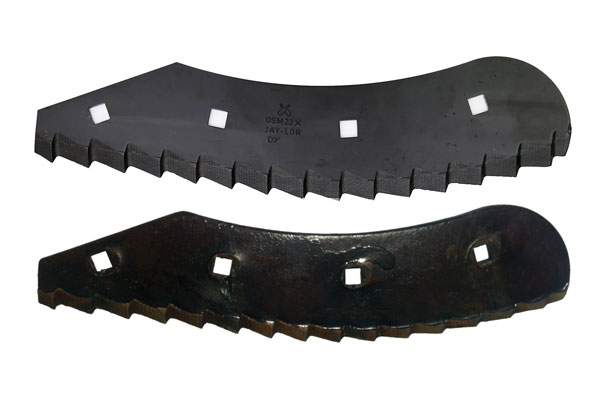
14. How long should TMR mixer knives last?
Published April 2017
Knives should be considered wearable parts of the TMR mixer, especially on dairies that feed baled forage.
Knife service life will be dependent on the materials they are made of and the characteristics of the forage being processed, not unlike the life of a tire on a vehicle, which is determined by the quality of the tire and how and where it is used.
Factors affecting knife wear include forage fibre, knife location, rocks and sand, and the type and quality of knives.
It is useful to periodically inspect the knives on the bottom third of the auger for wear by comparing them with a new knife. As the knife wears, the width of the coated area near the tip of the knife will decrease.
However, to determine sharpness, it is necessary to look at the edge of the knife to determine the degree to which it is rounded. It is this rounding that reduces cutting effectiveness.
Experience has shown replacing half of the knives more frequently improves mixer performance, reduces overall costs and often improves animal performance.
How often should mixer knife inspections occur?
“It should be sufficient to check mixer knives for wear every three months, for a mixer processing forage about an hour a day. This obviously depends on the type of forage being processed (e.g., good-quality hay [less wear] versus straw or cornstalks [more wear]) and the degree of contamination with dirt and rocks.
“When a machine is new, it may be useful to check the knives each month for the first three months to gauge the rate of wear.
“Once a reasonable period for changing and rotating knives for optimal performance has been determined, occasional checking for knife wear should be less important than changing the knives at the determined interval unless the ingredients used change appreciably."
"Remember, if the edge of the blade is not sharp enough to be concerned you may get cut if you slide your finger along its length, it’s not sharp enough to efficiently cut forage.”
—Alan S. Vaage, ruminant nutritionist, Jaylor Fabricating Inc.
Read the story here: How long should TMR mixer knives last?

15. Terpstras use genomics to verify breeding program
Published online February 2017, reprinted on next page
The heifer barn at Cranbrook Farms Ltd. in Brussels, Ontario, was getting crowded in the summer of 2016. Joe and Barb Terpstra decided to use genomics to aid in their culling decisions and also confirm whether their breeding program was actually meeting its goals.
They tested about 50 animals to get a good benchmark on their breeding program. “We just did it in the short term to see where we were at and where we want to go,” Joe Terpstra says.
Using the data they received, they were able to select and sell their lower genomic heifers to gain some space in the heifer barn. They were also able to see that decisions made by the mating company are resulting in calves with the genetics they want for the future of their herd.
Have you continued to use genomics on your farm?
“We have not continued to use genomic testing on our herd. It was a tool we used to measure the genetic selection of our current sires our Genex team is using, and we were happy with the results. For us, it is too expensive to be using on every calf.
“Selling open heifers did free up space but, in the long run, it ended up hurting us. Right after we sold them, extra quota was handed out, and we could have used those 50 extra heifers.
“Going forward, we will concentrate on making less expensive heifer rations with the use of double-cropping oats after wheat and doing a good job of raising calves and lots of heifers. We will make the decision to sell after freshening depending on how many we need to fill current quota and newly purchased.”
PHOTO: Joe and Barb Terpstra (centre) answer questions about their calf-raising program while hosting the Progressive Dairy Operators fall bus tour. Photo by Karen Lee.
—Joe and Barb Terpstra, dairy producers, Cranbrook Farms Ltd.
Read the story here: Terpstras use genomics to verify breeding program ![]()
